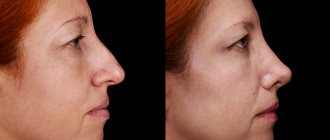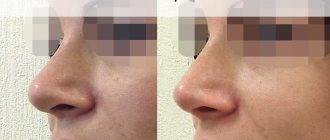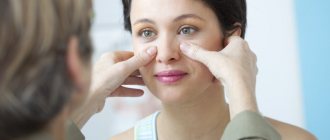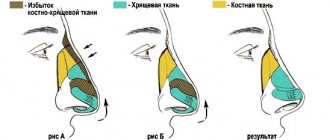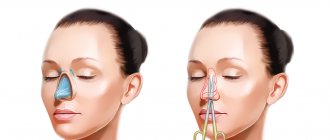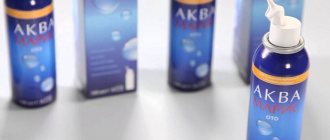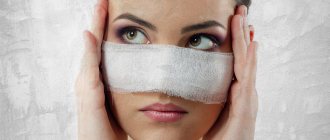Complete rehabilitation after rhinoplasty takes a year and is divided into three stages: early postoperative, main and late.
- The first stage takes 2-3 weeks, during which the swelling gradually decreases, bruising disappears, and anxiety and anxiety subsides. The doctor removes the fixing bandage or splint, but when exactly this happens - after 7 or 10 days, depends on the complexity of the operation. The patient's condition improves, and by the end of the early rehabilitation period he can return to normal life, albeit with a number of restrictions.
- The main stage of rehabilitation after rhinoplasty lasts up to 3 months. Swelling and bruising are no longer noticeable, but a gentle regimen continues to be relevant. Tissue healing and functional restoration continue.
- The late recovery period after rhinoplasty lasts from the third to the 12th month. After a year, you can evaluate the result: the nose takes its final form, respiratory functions are completely restored.
A year after rhinoplasty, the patient can lead a pre-operative lifestyle: all restrictive rules and prohibitions are canceled.
Recovery after closed rhinoplasty is a little faster. In this case, rehabilitation is completely completed after 3-6 months, which is explained by less trauma to tissues and blood vessels during the operation.
What are the age restrictions for rhinoplasty?
The operation can be performed on patients over 16 years of age, but with written permission from their parents. At this point, young people reach puberty and the body, including the face, ceases to undergo changes due to the process of growth. However, the bones of the skull are finally formed by the age of 20, so surgeons advise focusing on this age, or rather the period from 20 to 35 years, while the body is young and has a lot of strength to recover. From the age of 40, the healing and regeneration processes slow down - plastic surgery is less desirable.
The upper limit is 70 years, after this age rhinoplasty is not performed.
Rarely and for medical reasons (if there is an obstruction to normal breathing), operations are performed on patients under 16 years of age.
Main and late recovery period
The main recovery after rhinoplasty occurs within three months. During this period, you can return to an active social life: study, work, hobbies, active recreation. The osteochondral tissue fuses completely, and most of the previously existing restrictions are lifted.
The late rehabilitation period after rhinoplasty is not accompanied by discomfort. There are certain restrictions, but they are few: for example, manual and hardware facial massage cannot be done for at least six months after surgery. Of course, during the rehabilitation year you need to be extremely careful in your home or work environment, during outdoor activities or sports.
It is important to understand that a responsible attitude towards your health and compliance with all recommendations is an indispensable condition for the successful completion of such a complex operation as rhinoplasty.
Are there any scars left after the surgery?
The site of any incision is replaced by connective tissue, which is a scar. It is impossible to avoid its formation, but what is important is where it is located and how strongly it is expressed. So, after closed rhinoplasty there are no external traces of the intervention; after open rhinoplasty, a barely noticeable scar remains near the columella and under the nose. Thick and dark skin is more susceptible to scarring. Age also affects the likelihood of scars appearing - the older the patient, the slower the soft tissues heal and the more noticeable the scars.
Indications for rhinoplasty
Indications for rhinoplasty can be divided into aesthetic and functional. However, in practice, the patient often experiences both. Thus, a curved internal septum makes the nose asymmetrical (aesthetics) and, at the same time, makes breathing difficult (function).
Indications for surgery:
- Deformations of individual parts of the nose (congenital anomalies and post-traumatic asymmetry).
- Violation of the physiological functions of the nose (impaired nasal breathing) of a post-traumatic nature.
- Asymmetry caused by uneven growth of the facial bones.
- Individual patient dissatisfaction with the shape, length or width of the nose, the shape of the nostrils, the tip or back of the nose.
When performing rhinoplasty, one of the most important factors must be taken into account – age. The earliest age for surgery is considered to be 18-20 years. It is better not to operate before the age of 18 (except for severe deformation), since the formation of the facial skeleton is not completed until this age.
How long does it take for a nose to heal and when can you see the final result?
The healing time depends on what type of surgery was performed. On average it is 2 weeks. The final result is visible after a year, when new appearance features become apparent and fully formed. The preliminary effect can be assessed after 3 months, but it is worth remembering that the main postoperative swelling can last up to 6-12 months. Therefore, the nuances do not appear in the 3rd month.
! All types of rhinoplasty in our clinic - more information about the rhinoplasty procedure, cost, reviews, before and after photos
Preparing for surgery
Rhinoplasty is a full-fledged surgical operation, which is performed under general anesthesia, so approximately two weeks before the operation you need to undergo a medical examination: pass the necessary tests and examination by specialists
Contraindications
Diseases of the cardiovascular system in severe form (coronary heart disease, heart attack, circulatory failure, hypertension)
Any chronic diseases in the acute or decompensation stage (peptic ulcer, bronchitis, pyelonephritis, diabetes mellitus, etc.)
Oncological diseases
Psycho-neurological diseases
Systemic connective tissue diseases (systemic lupus erythematosus, rheumatism, glomerulonephritis)
Colds (acute respiratory infections, acute respiratory viral infections) until complete recovery
The operation is not performed during menstruation. The date of the operation must be set no later than three days before the start of menstruation and no earlier than three days after the last day of menstruation.
It is advisable for smokers to give up the harmful habit or limit their consumption of cigarettes no later than 1 month before the date of surgery.
Anesthesia for rhinoplasty
For rhinoplasty, depending on the scope of the operation, 2 main types of anesthesia are used:
- General anesthesia
- Local anesthesia
Duration of rhinoplasty surgery
The duration of rhinoplasty depends on the planned volume of the operation and can range from 1 to 3 hours, or more hours for complex reconstructive interventions.
Rhinoplasty methods: open and closed rhinoplasty
The nose is the most prominent and distinctive part of the human face, which gives it special character, personality and beauty.
The ideal of a beautiful face as we know it today was promulgated by the works of Leonardo da Vinci (1452–1519) and Albrecht Dürer (1471–1528).
The peculiarity of rhinoplasty is its dual approach, namely that it should improve not only the aesthetics of the nose, but also restore nasal breathing.
Even a small nose correction can significantly change the appearance of your face. Therefore, a set of reliable technical techniques in the operating surgeon’s arsenal and their correct use are of great importance.
As in all areas of surgery, the determining factor for the success of manipulations is good surgical access. However, in aesthetic surgery, the choice of convenient access is limited by considerations of the cosmetics of the postoperative scar.
There are different approaches in rhinoplasty
- internal, or closed (endonasal)
- external, or open (extranasal).
Closed rhinoplasty
The incision in closed rhinoplasty is located in the vestibule of the nose, so the resulting scars are not visible outwardly. Closed rhinoplasty allows you to solve almost any problem in correcting the osteochondral pyramid of the nose, but this approach significantly limits the freedom of action at the tip of the nose.
Also, closed rhinoplasty has another big drawback, which is that most of the actions of the plastic surgeon occur without visual control, which can lead to unpredictability of the result of rhinoplasty.
There are the following types of closed rhinoplasty approaches:
- anterior or marginal
- middle, or transcartilaginous,
- posterior, or intercartilaginous.
Anterior or marginal approach for closed rhinoplasty
It is mainly used to correct the wings and tip of the nose.
Technically, the incision is made 2 mm from the edge of the nostril along the anterior edge of the lateral pedicle of the large cartilage of the nasal wing with a transition to the medial pedicle.
This access is then connected to the access on the opposite side of the nose, leaving the columella skin intact.
After the incision is made, the soft tissue is detached, thereby exposing the surface of the large cartilage of the nasal wing.
The disadvantages of this approach are the possibility of damage to the greater alar cartilage, the inability to freely approach the bony part of the nose and the lateral cartilage, and the fact that the scar located at the free edge of the entrance in the vestibule of the nose can cause deformation of the nostril and the occurrence of cicatricial stenosis.
Middle or transcartilaginous approach of closed rhinoplasty
The incision with this approach provides a good view and access to both the large cartilages of the nasal wing and the lateral cartilages, as well as the septum and bony part of the nose.
Technically, the incision is made approximately in the middle of the lateral crus of the greater cartilage of the alar cartilage behind its medial crus. In this case, the cut looks like the letter U.
The anterior (short) leg of the incision separates each part of the nasal septum from the caudal edge of the quadrangular cartilage. This part of the incision is made simultaneously on both sides, and then, with the help of an auxiliary tie, the columella is pulled downwards, in which the medial legs of the large cartilages of the nasal wing remain intact. The long leg of the incision passes through the bend of the lateral crus of the greater wing cartilage at a distance of 4 mm from its lower edge.
Posterior or intercartilaginous approach of closed rhinoplasty
Indications for this access are manipulations in the bony part of the nose.
The incision is made along the posterior edge of the large wing cartilage in a U-shape, between it and the anterior edge of the lateral cartilage.
Open rhinoplasty
Open rhinoplasty provides the best view, allowing the surgeon to accurately assess specific nasal deformities. This is especially important during revision rhinoplasty and interventions to change the size of the nose. External access provides the plastic surgeon with ideal conditions for working on all parts of the tip of the nose, nasal septum and has no disadvantages for correcting the nasal pyramid. In clinical work, I most often use open rhinoplasty.
Open rhinoplasty is used
- when high precision is required,
- when during rhinoplasty it is necessary not only to improve the shape of the nose, but also to improve nasal breathing,
- when maximum predictability of rhinoplasty is needed.
The first part of the incision in open rhinoplasty passes transversely through the columella, and the second part, as with the internal approach, passes in the vestibule of the nose along the anterior edge of the lethal pedicle of the alar cartilage. This approach is otherwise called transverse transcolumellar.
Open rhinoplasty must be performed by a novice doctor in all cases, since if, when starting to perform rhinoplasty, he uses only a closed technique, then he gets used to the low accuracy of the results of rhinoplasty and, as a result, to poor quality.
But the doctor who starts with open rhinoplasty and gradually switches to closed rhinoplasty gets used to the exact opposite - to great accuracy, high quality and predictability of results.
Thus, of the two existing surgical approaches, external and internal, the latter is more cosmetic, since it does not leave external scars, while the external access provides visual control and freedom of manipulation.
How to speed up healing?
How long the rehabilitation lasts, the timing of tissue restoration - all this is determined individually. To shorten this period as much as possible, the patient is given a number of recommendations, for example:
- sleep in a half-sitting position,
- avoidance of salty and spicy foods,
- restriction of sports and physical activity,
- quitting smoking and alcohol,
- ban on visiting bathhouses, saunas,
- ban on hot baths,
- ban on solariums and beaches,
- restrictions on wearing glasses.
Thermal procedures stimulate blood flow to the affected tissues and delay their recovery. The same is true for physical activity, especially those involving bending the body or head forward, as well as alcohol and cigarettes. Therefore, to speed up healing, it is highly recommended to avoid these things. It is also undesirable to visit the pool, and the plaster cast should not be wetted even while taking a shower or other hygiene procedures.
Complications
Rhinoplasty is a complex operation, so even the most experienced surgeon cannot guarantee zero risk of complications. In cases where noticeable deviations from the norm are observed during the rehabilitation period, you should immediately visit your doctor. This may include prolonged swelling, nasal discharge in the later stages, fever, general soreness, and the like.
Rehabilitation after rhinoplasty surgery has its own time frame for each patient and proceeds individually. But still, there is a certain variant of the norm, going beyond which is a sufficient reason to consult a specialist. Therefore, in any unusual situations, it is better to contact the surgeon who performed the operation.
One week after rhinoplasty
Following restrictions after rhinoplasty allows for a faster recovery. Observation in a hospital is required for 1 day, after which you can return home. The most common symptom after rhinoplasty is swelling. On the recommendation of a doctor, medications are used to prevent inflammation.
The plaster splint is removed approximately one week after the procedure. You cannot remove it yourself without a doctor’s permission. The shape of the nose changes over several months; the result, which is visible immediately after removing the plaster cast, is not final.
The first days after rhinoplasty
Many patients are interested in how life will change after rhinoplasty in the first few days. Patients often experience bruising and swelling. What does the nose look like immediately after rhinoplasty? The hue may change to blue-violet, but it disappears in about 2-3 days.
After removing the plaster during rhinoplasty, the blue tint is no longer present and the color becomes natural. Hematomas under the eyes may persist for some time. How long does it take for your nose to breathe after rhinoplasty? For the first three days you can breathe mainly through your mouth. For the first 10 days, a splint is placed on the nose. After its removal, swelling and difficulty in nasal breathing may increase. After the swelling subsides, breathing will resume.
